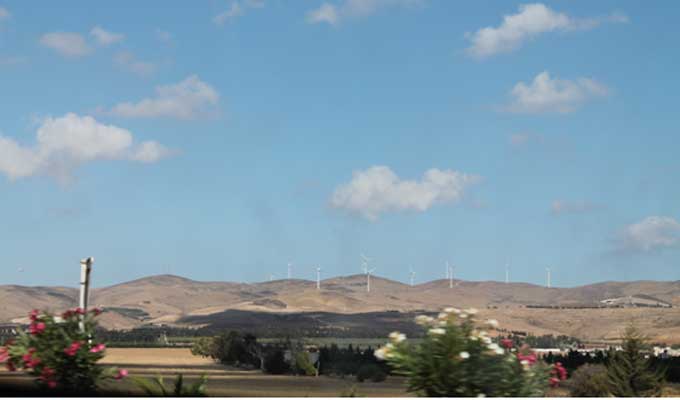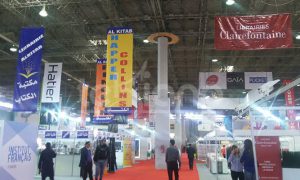Avec deux principaux sites, l’un à Haouarya, l’autre à Bizerte, la production d’électricité par énergie éolienne prend de plus en plus sa place en Tunisie. Assurant jusqu’au jour d’aujourd’hui les 245 MW de production, le gouvernement Tunisien vise à atteindre les 835 MW capturés en 2020, en l’occurrence une quantité de 1755 MW à la périphérie de 2030.
Wind Energy and the Tunisian strategy of electricity production
Wind Energy has become lately, one of the most important resources one can investigate in order to get electricity.
Howerver, Tunisia is getting into the flow. The Tunisian government plans to reach the quantity of 835 MW of Energy captured by Wind Turbines, in 2020, then the 1755 MW around 2030 [1].
Indeed, thank to ‘l’Atlas Eolien’; the distribution of Wind in Tunisia is given as follows [2]:
-Interesting Winds: The wind speed exceeds 6.5 m/s in a height of 60m. We find these winds in the Eastern part of the country: Tozeur, Kebili, Tataouine, East of Medenine and Monastir.
-Good Winds: The wind speed exceeds 7m/s in a height of 60m. The geographical area where these winds are operating is located in the north and eastern north (Nabeul and Bizerte), but also in the center of the country (Kasserine) and the eastern-south part of it (Tataouine, Medenine, Gabes)
-Very Good Winds: The wind speed exceeds 8m/s. This is the case in some regions of the north, eastern north and eastern-south of the country.
Hence, it is important to notice the realizations of Tunisia in the field of Wind Energy Production. Its natural resources enables it as of today, to produce the total of 245MW by mean of Wind Turbines installed into two principle sites that are: Sidi Daoued (Haouarya) and Metline-Kchabta(Bizerte). The two projects are supported by STEG (Tunisian Society of Gaz and Electricity).
The Haouarya’s wind farm operates actually with an outcome of 54MW of electricity, with a capcity of 70 turbines, AE-61 made by the manufacturer Gamesa*. This allows the production to reach the 150 GWh/year.
The Bizerte’s farms achieves on its own the quantity of 190 MW, with a production per year equal to 600 GWh. We count 143 turbines implanted, all manufactured by Gamesa.
A second park in the same region is under construction in Kechabta* and aims to reach the 45MW with a capacity of 150GWh year prodcution [3].
Besides, an offshore site is in progress for the Tunisian government. We note ELMED project insured by Connexion with Italy [4]. It targets the transit of 1000 MW where 200 MW by mean of renewable resources, extended over 200km long.
Another project in collaboration between ANME (National Agency for Energy Conversion)-PNUD (Programme des Nations Unies pour le Développment)-FEM(Fonds pour l’Environnement Mondial) plans to imply the private sector in this area, in a sense to connect the extracted wind energy to the electric grid.
It is to notice in this context, the implication of several engineering schools to spread the technology. The Wind Energy module is considered and lectures on renewable resources as good as materials and aerodynamics of wind Turbines are assured in many institutes –be it public or private ones – such as ENSTAB (National School of Sciences and Advanced Technologies Borj Cedria) MedTech (Mediterranean Institute of Technology ).
*Gamesa is a Spanish pioneer in the wind turbine industry, in which it has played a leading role for the last fifteen years, via two turbine platforms (Made AE5X- 800 kW and Made AE61 – 1320 kW), …
*Kechabta : Jebel Kechabta is a hill in the region of Bizerte.
References :
[1] « Stratégie nationale de maitrise de l’énergie, objectifs moyens en enjeux », Juin 2014.
[2] « Opportunités de développement de l’autoproduction électrique à partir de l’énergie éolienne en Tunisie », GIZ, Tunis 17 et 18 mai 2011.
[3] « Opportunités de Développement de l’éolien en Tunisie », N. Baccari, Tunis 24 Juin 2014.
[4] « Projet ELMED: la première liaison transméditerranéenne en courant continu. Quelles conséquences sur le système électrique Tunisien ? », Réunion MEDELEC , Alger 27-28 Septembre 2010.
Tribune libre Nedia Aouani Assistant Professor @ENSTAB Borj Cedria
Plus : Actu Ness News












